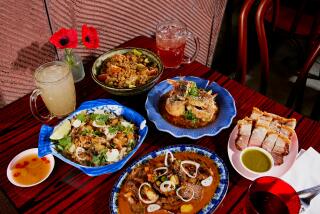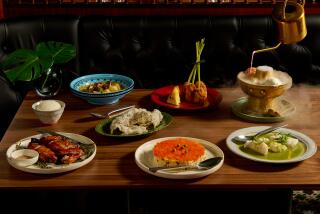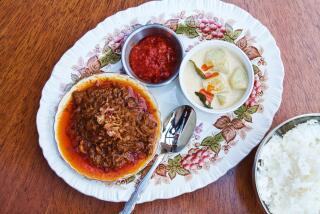The Ultimate Thai
If you are serious, really serious, about Thai cooking, you will appreciate Su-Mei Yu’s new book, “Cracking the Coconut: Classic Thai Home Cooking” (William Morrow, $30.) If you’re not a serious cook but just love Thai food, buy the book anyway. It will teach you a lot about your favorite dishes (Yu provides three versions of pad Thai) and enough about ingredients and techniques to allow you to distinguish genuine Thai cooking from the adaptations all too often found in American Thai restaurants.
Yu is chef and owner of Saffron restaurant in San Diego. She has also cooked on the streets of Bangkok. That happened when Yu, in the course of researching pad Thai, was assigned to produce the dish for a long line of customers at a street stand. Such stories are scattered throughout the book, making it fun to read as well as informative.
Like many other Thais, Yu is of Chinese ancestry. At age 5, she entered Wattana Wittaya Academy in Bangkok, an exclusive boarding school that began as a training center in the royal palace. The school was founded during the era of King Chulalongkorn (1868-1910), under whom, Yu says, Thai cooking reached its peak.
She provides that ruler’s personal recipe for apple and smoked salmon salad. (Of course, the salmon is a substitute for the original dried shrimp).
Despite that adaptation, in general Yu advocates authentic ingredients and procedures, so this is not a book for cooks seeking easy shortcuts to Thai food. This might seem to be contradicted by recipes for baloney salad and canned salmon with coconut cream sauce, but in each case the convenience ingredient actually has been adopted into the Thai kitchen. During the ‘50s and ‘60s, Thais considered it smart to cook with canned foods, Yu writes. They learned to make a luncheon meat that resembles baloney from European immigrants.
Although Yu promotes authenticity, she does offer alternatives for ingredients that are difficult to find: pureed dried apricots for fresh tamarind, for example, and Belgian endive for banana blossom. “The fun of cooking Thai food is in part the discovery of a new world of exotic ingredients,” she says. In Los Angeles, with its large Thai community and well-stocked Thai markets, that is especially true.
More to Read
Eat your way across L.A.
Get our weekly Tasting Notes newsletter for reviews, news and more.
You may occasionally receive promotional content from the Los Angeles Times.








